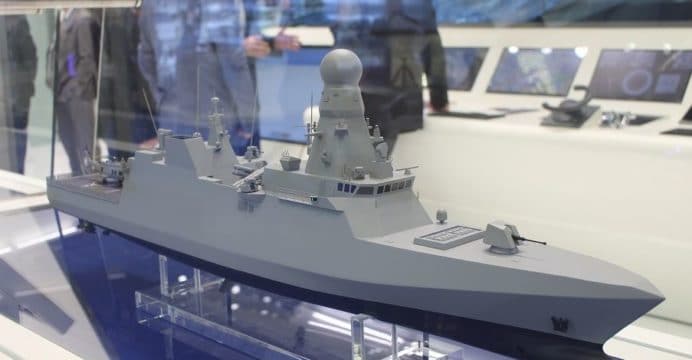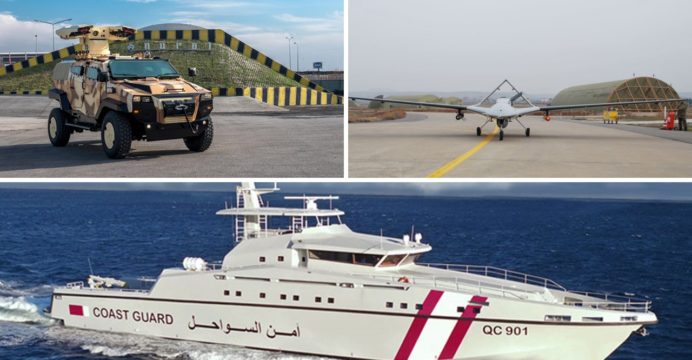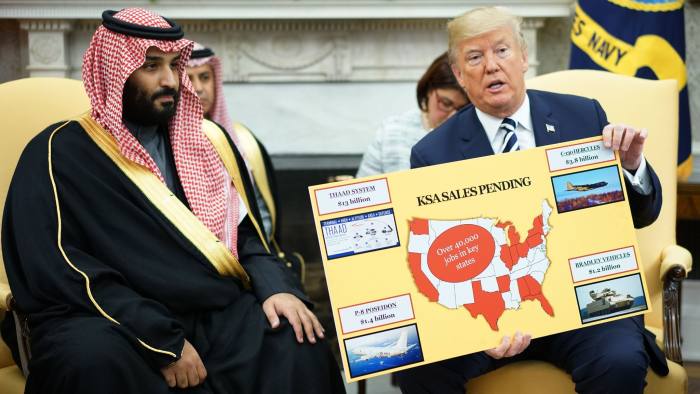President Donald Trump says the Saudis are a “big purchaser” of American arms. A $3.5 billion discount they won from the Pentagon last year in buying
for $15 billion shows they’re also adept at tapping into the Pentagon’s generosity.
Welcoming Saudi Crown Prince Mohammed Bin Salman to the White House on Tuesday, Trump said the kingdom has completed $12.5 billion in purchases of planes, missiles and frigates from U.S. companies since his visit to Saudi Arabia last year.
He didn’t mention the discount granted last April on the Thaad system from
The price break, which hasn’t previously been reported, was approved after the Saudis claimed the sale could be lost without it. It came in the form of two waivers from a U.S. law requiring foreign purchasers of American weapons to pay part of the Defense Department’s costs in developing them.
The sale, announced in October, was only the second time the U.S. has allowed the Army’s Thaad anti-missile system to be sold for export, after a sale to the United Arab Emirates. The Thaad batteries deployed in South Korea are owned by the U.S.
A month after the sale was announced, Russia disclosed that it was selling Saudi Arabia its S-400 air defense system, which it asserts is equal in capabilities to Thaad.
Largest Yet
The Saudi waivers were the largest yet approved for any nation, based on a Government Accountability Office review published in January of the discounts from 2012 through 2017. Over those years, the Pentagon approved $9.2 billion in waivers to allies, mostly from the Middle East, on the rationale of preventing lost sales. That includes about $4.5 billion last year, including the Saudi waivers, the first year of the Trump administration, up from about $500 million in 2016.
The GAO highlighted the $3.5 billion in waivers without naming Saudi Arabia. A U.S. official familiar with the data, who spoke on condition of anonymity, confirmed the Saudis were the beneficiaries.
Not all of the waivers approved necessarily ended up at the initial amounts cited in the review, according to the GAO.
While the discounted arms sale reflects Trump’s priority on building alliances with Saudi Arabia -- and in countering the regional influence of its arch rival Iran -- it raises questions about the policy of giving wealthy nations a break from contributions toward weapons development costs that otherwise would go to the U.S. Treasury.
Taxpayers’ Burden
“American taxpayers are footing the bill for billions of dollars for researching and developing the weapons we sell to foreign governments.” Representative Jackie Speier of California, a Democrat who serves on the House Armed Services Committee, said in a statement.
“The Gulf Arab nations are among the richest in the world” so “they can certainly afford it,” said Speier, who joined a colleague in requesting the GAO report. Yet the Pentagon’s Defense Security Cooperation Agency, or DSCA, “repeatedly and without examination bought the absurd claim that paying those reimbursements would cause Gulf nations to call off” deals, said Speier, who added that she’s exploring options to tighten oversight of the DSCA.
‘Carefully Evaluate’
Senator Robert Menendez, the ranking Democrat on the Senate Foreign Relations Committee, said in a statement to Bloomberg News that he’ll pursue an explanation for the Saudi waivers.
“We need to carefully evaluate all our military assistance and arms sales to Saudi Arabia, as we do with any country,” the New Jersey senator said. “I plan to ask the Administration why it granted Saudi Arabia a waiver exempting it from reimbursing the United States” for “an expensive missile system, and how this contributes to our national security. I would seriously question this waiver for such a wealthy country,” even though “Saudi Arabia remains an important security ally.”
A law requires foreign buyers of American military systems to reimburse a share of the one-time or “nonrecurring” research and development costs borne by taxpayers. In addition to the risk of lost sales, a waiver can be granted if a potential customer makes a case that the sale will improve “commonality” with the U.S. military through the use of standard weapons. These types of waivers are available for sales to NATO allies, Australia, South Korea and Jordan, the GAO found.
99% Approval Rate
The defense agency approved $16 billion, or 99 percent of waiver claims, for various reasons from 2012 through 2017. A waiver is issued almost routinely when a customer claims the sale will be lost without it, according to the GAO.
A congressional aide official familiar with the data the defense agency gave to the GAO said it showed Saudi Arabia had won 57 waivers totaling $4.82 billion, including the Thaad sale. Other waivers totaled $2.6 billion to Qatar, $767 million to the United Arab Emirates and $328 million to Kuwait.
DSCA spokesman Tom Crosson said in an email that “we’ll be able provide you with additional details” about the report “after we provide our inputs to Congress.” Foreign military sales support “various foreign, national security, and economic policies,” he said.
“Losing sales can significantly impact these key objectives, and nonrecurring cost waivers are one way we ensure we are a competitive option for our allies and partners,” he said.
Vice Admiral Joseph Rixey, who was director of the DSCA at the time, told Speier at a June 2016 hearing that he waives costs “in accordance with the Arms Export Control Act. That authority has been delegated from the president down to the secretary of defense and down to me.”
Rixey was still agency director last year, when the Saudi waivers were approved. He joined Lockheed in November as vice president of international program support. Lockheed spokesman Maureen Schumann said the company declined to comment on the report of Thaad waivers.







